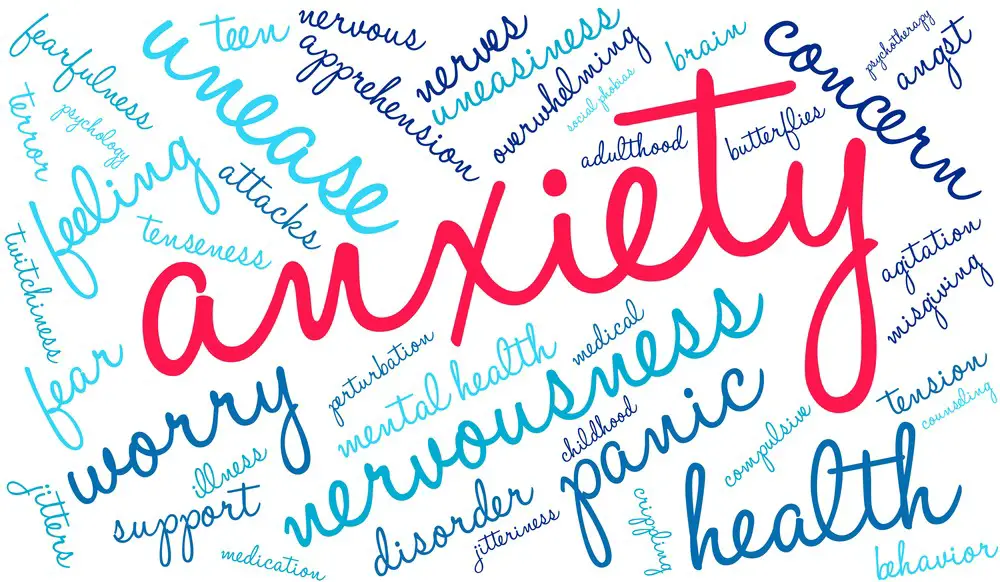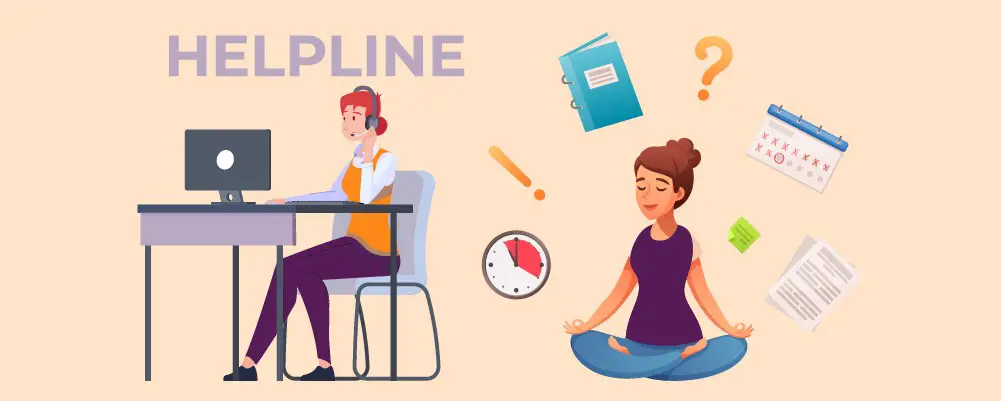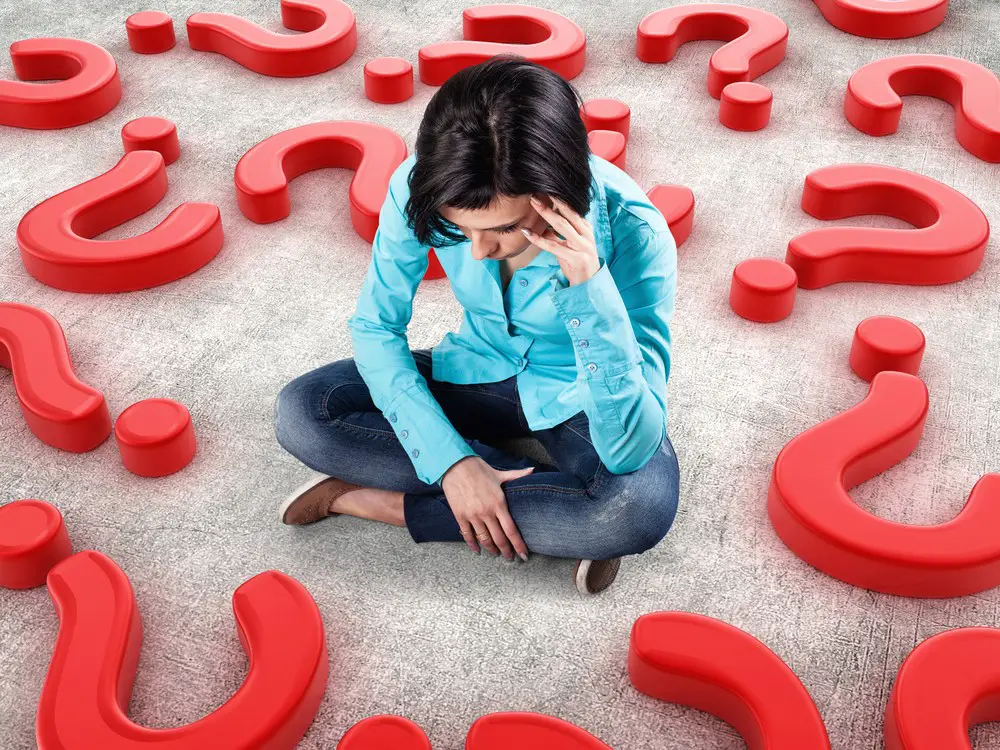As a BetterHelp affiliate, we receive compensation from BetterHelp if you purchase products or services through the links provided
Anxiety is a complex and misunderstood emotion that many people experience. It often involves intense uneasiness, fear, or worry that can disrupt daily life. While everyone experiences some level of anxiety, understanding what triggers it and how it manifests can be challenging for those who haven’t experienced it or struggle to articulate their experiences.
When describing anxiety to someone, it is essential to emphasize that it is a valid and real experience for many individuals. It is not simply an overreaction to trivial situations but a response to an internal or external stimulus that can lead to feelings of apprehension, distress, and even physical symptoms. The conversation can provide a clearer insight into the complexities of living with anxiety by discussing the different types of anxiety disorders, their common triggers, and how they can affect interactions with others.
Key Takeaways
- Anxiety is a real and complex emotion that can disrupt daily life
- Understanding triggers, and physical symptoms can help in describing anxiety
- Discussing different types of anxiety disorders and their effects on relationships can provide valuable insight

Understanding Anxiety
Anxiety is a common and complex emotion that can affect people in various ways. At its core, anxiety embodies feelings of fear, worry, and stress, making it an essential aspect of the human experience. It’s crucial to distinguish between situational anxiety and anxiety disorders, as understanding these differences will help people empathize with those who suffer from chronic anxiety.
Experiencing anxiety in certain situations is entirely natural. Harmless anxiety includes nervousness before an important meeting or stressing over a deadline. These instances may temporarily cloud one’s mental health but ultimately subside as the situation passes. In these cases, the anxious feelings might be beneficial, driving focus and yielding better results.
However, it may indicate an anxiety disorder when anxiety interferes with daily functioning and becomes persistent. Anxiety disorders are not as simple as fleeting feelings of stress or concern but rather create immense and persistent distress in an individual’s mental health. To comprehend the impact anxiety disorders can have, it’s vital to consider the following areas:
- Physical symptoms: Shaking, increased heart rate, sweating, difficulty breathing, and other uncomfortable sensations can manifest due to anxiety. These symptoms can be debilitating and make it challenging to focus on everyday tasks.
- Emotional distress: The worry and fear accompanying anxiety disorders often lead to feelings of helplessness or a sense of being “trapped” in one’s mind. These emotions can be incredibly isolating, creating a barrier between the individual and their world.
- Cognitive impact: Anxiety can disrupt one’s thinking processes, leading to racing thoughts, difficulty concentrating, or even memory issues. This cognitive fallout can hinder one’s decision-making ability or lead a fulfilling life.
To foster genuine empathy and understanding, it’s essential to appreciate that anxiety is not a one-size-fits-all affliction. Instead, it comprises various levels and types, affecting each individual differently. With this comprehensive perspective, we can support those struggling with anxiety, provide a helping hand, and contribute to better mental health.
Also read
ADHD or Anxiety? Take Our Quiz to Find Out
Nervousness vs Anxiety: Understanding the Key Differences
When to See a Doctor for Anxiety: Identifying the Key Signs

Physical Symptoms of Anxiety
Anxiety can manifest in various physical symptoms, which may seem unrelated. However, understanding these symptoms gives us insight into how anxiety affects our bodies.
Experiencing an increased heart rate or heart palpitations is common during anxiety episodes. Your heart might feel like it’s racing, or you might even feel it skipping a beat. These palpitations can be quite concerning, and, in some cases, they might even lead to feelings of chest pain.
Shortness of breath is another symptom that often accompanies anxiety. You may find it difficult to take a deep breath or feel as though you can’t catch your breath. This distressing sensation can intensify the anxiety episode, creating an exhausting cycle.
As anxiety creeps in, you might notice yourself sweating more than usual. The body’s response to stress may trigger this sweat, and it’s not uncommon for anxiety sufferers to become hyper-aware of it. Remember, acknowledging the symptom can help alleviate the intensity of the reaction.
Physical discomfort doesn’t end there. People with anxiety frequently report headaches. These can be anything from a mild, dull ache to more painful.
Lastly, trembling or shaking is often associated with anxiety. You may feel a strange quiver in your hands, or your entire body might tremble. This sensation can be particularly unnerving, but recognizing it as a byproduct of anxiety can help you manage it better.
In summary, anxiety has many physical symptoms, including increased heart rate, heart palpitations, chest pain, shortness of breath, sweating, headaches, and trembling. Being aware of these symptoms and identifying them as anxiety-related can assist in handling anxious moments with more confidence and ease.
Anxiety Triggers and Emotional Responses
Anxiety is a prevalent emotion that most people experience at some point in their lives. Triggers are the events or circumstances that spark anxiety, leading to various emotional responses. Identifying these triggers is essential in understanding how to cope with anxiety.
One common trigger is the perception of doom or an imminent threat. This feeling may lead to a racing heart, sweating, and panic attacks. In some instances, panic attacks and anxiety attacks become intertwined, making it difficult to differentiate between them. These emotional responses can be overwhelming, causing an individual to feel trapped and helpless.
Another significant source of anxiety can be negative thoughts. When someone focuses on failures and dwells on expectations that fall short, depression may start lurking around the corner. Coinciding with depression, anxiety may manifest as nervousness, restlessness, or constant worry.
Coupled with negative thoughts, external factors such as work or relationships may also trigger anxiety. A person may feel increasingly nervous in a high-pressure situation or when facing traumatic events. This emotional response can often leave them struggling to manage both their anxiety and daily responsibilities.
Here are some common anxiety triggers and emotional responses:
- Perception of doom: panic attacks, anxiety attacks, feelings of entrapment
- Negative thoughts: depression, nervousness, restlessness
- External factors: stress from work or relationships, traumatic events, increased worry
Recognizing these triggers and emotional responses allows individuals to understand their anxiety better. They can take appropriate steps to manage their emotions by identifying potential setbacks. The key to overcoming anxiety lies in self-awareness and a deep understanding of the triggers and emotional responses that affect a person’s mental well-being.

Social Anxiety and Relationships
Social anxiety can be a challenging obstacle for individuals who experience it, affecting their capacity to establish and maintain relationships. While it’s true that everyone feels some degree of anxiety in social situations, especially when meeting new people, those suffering from social anxiety often have heightened feelings of insecurity and self-consciousness.
Having a partner grappling with social anxiety can elicit additional stress and complications in relationships. Loved ones may initially struggle to fully comprehend the extent of their partner’s anxiety, leading to misinterpretations and misconceptions. A support system is crucial for those afflicted with social anxiety, as it can help them overcome negative stereotypes and foster stronger connections with others.
Low self-esteem is another widespread challenge among individuals with social anxiety, as it undermines their self-worth and often fuels feelings of shame. This, in turn, may strain the relationship, as the afflicted may find it challenging to believe they deserve love and affection. Consequently, they might inadvertently push their partners away out of fear and insecurity.
To counteract this, open communication and reassurance can play pivotal roles in easing the social anxiety one experiences within relationships. By lending a listening ear and providing encouragement, loved ones can effectively aid the individual in their journey towards increased self-confidence and emotional well-being. Offering support and understanding allows them to gradually break through the barriers social anxiety has imposed on their relationships, ultimately creating stronger and more resilient bonds.
The key to navigating social anxiety in relationships is patience and empathy. By fostering a supportive environment and addressing the symptoms with care, those affected can work toward overcoming their anxious tendencies and cultivating a stable, fulfilling connection with their partners.

Different Types of Anxiety Disorders
Feeling the weight of anxiety is something many people can relate to. However, not all anxiety is created equal. There are several types of anxiety disorders, each presenting unique challenges and experiences. In this section, we’ll touch upon generalized anxiety disorder, panic disorder, substance-induced anxiety disorder, separation anxiety disorder, phobias, social anxiety disorder, and unspecified anxiety disorder.
Generalized Anxiety Disorder (GAD) affects individuals by causing excessive worry and tension in everyday situations. Often, people with GAD find it difficult to control their anxiety, and it interferes with their daily lives. They may experience fatigue, irritability, restlessness, and difficulty concentrating, even when there’s no apparent reason for concern.
Individuals with Panic Disorder may suddenly experience intense fear, often called panic attacks. These attacks can lead to physical symptoms such as heart palpitations, shortness of breath, and dizziness. The fear of having another panic attack can be so overwhelming that it may create a vicious cycle of anxiety.
Substance-Induced Anxiety Disorder is triggered by using or withdrawing certain substances, be it alcohol, drugs, or medications. Dependency and withdrawal can lead to heightened anxiety, causing symptoms similar to other anxiety disorders.
Separation Anxiety Disorder is commonly associated with children but can also affect adults. It stems from the fear of being away from loved ones, resulting in extreme distress when separation is imminent or occurring. Individuals may have nightmares, experience physical symptoms, or avoid situations where separation is likely.
An irrational and overwhelming fear of specific objects, situations, or activities characterizes phobias. Common examples include arachnophobia (fear of spiders) or fear of bugs, claustrophobia (fear of enclosed spaces), and acrophobia (fear of heights). These fears can lead to avoidance behaviors and significant disruption in one’s life.
Social Anxiety Disorder often manifests as a fear of social situations where others may scrutinize or judge one. This can result in extreme self-consciousness and avoidance of social events, making it difficult for individuals to form and maintain relationships.
Lastly, Unspecified Anxiety Disorder is diagnosed when an individual experiences anxiety symptoms that don’t fully align with any specific anxiety disorder. While this category may seem vague, it emphasizes the need for further evaluation and individualized treatment.
In summary, each anxiety disorder poses unique challenges for those affected. It’s essential to recognize these distinctions and seek appropriate help to manage them effectively. The journey to mental well-being may be challenging, but understanding the different types of anxiety disorders is a vital step.

Diagnosis and Treatment Options
When it comes to anxiety, obtaining a proper diagnosis is paramount. Only then can one explore the various therapy and treatment options available. Anxiety should never be underestimated as it’s a mental illness that can profoundly impact a person’s life.
First, seeking help from a professional therapist or a mental health expert is highly recommended. They can accurately assess the situation and tailor a specific action for managing and alleviating anxiety. Moreover, a sense of reassurance comes from knowing that an experienced professional is guiding you.
Treatment options for anxiety are quite diverse. One popular and proven method is exposure therapy. Under the guidance of a therapist, this technique involves gradually and systematically confronting the source of one’s anxiety. The aim is to help the individual build resilience and, ultimately, reduce their anxiety in the long run.
For some people, a unique blend of therapy styles might be the best course of action. Integrating elements from traditional cognitive-behavioral therapy, mindfulness techniques, and interpersonal therapy may provide a comprehensive and highly personalized treatment plan.
Another pivotal aspect of managing anxiety is the support system. Seeking help from friends, family, or support groups can play a vital role in coping with and eventually overcoming the illness. Sharing experiences, building a network of understanding, and developing a sense of belonging can significantly boost one’s emotional strength.
So, there you have it – embarking on healing anxiety begins with the proper diagnosis. From there, exploring various therapy options, working closely with professionals, and engaging with a support network will pave the way to a more balanced life without the constant cloud of anxiety looming overhead. Remember, seeking help is not a sign of weakness; it’s a testament to one’s strength and desire for a better, healthier life.

Coping Mechanisms and Strategies
Feeling anxiety can be overwhelming, but don’t fret! There are various coping mechanisms and strategies to help manage these uneasy emotions. By practicing these techniques, individuals can take control and minimize anxiety’s impact.
One highly effective strategy is deep breathing. When anxiety strikes, take slow, long breaths, inhaling through the nose and exhaling through the mouth. Focusing on breathing can help regulate the heart rate and bring a sense of calmness, relieving tension.
In addition to breathing, numerous coping mechanisms can ease anxiety. Some proven techniques include:
- Mindful meditation, which promotes being present and fully engaged in the current moment
- Progressive muscle relaxation, where tension is systematically released from various muscle groups
- Physical exercise as it releases endorphins and boosts mood
It’s important to remember that having some anxiety in life is normal, and accepting this reality can help tremendously in coping. Accept the feeling for what it is, and try not to judge or criticize yourself for experiencing it. This mindset enables you to view anxiety from a more neutral standpoint.
Reassurance can also go a long way in managing anxiety. Surrounding yourself with understanding individuals who can provide comfort and support during difficult times can be incredibly beneficial. Sometimes, simply talking with someone who cares and empathizes can help diminish the intensity of anxiety.
In dealing with anxiety, it’s imperative to stay in control. Make a plan based on the strategies and techniques mentioned earlier, and empower yourself to take charge of your emotions. By doing so, you’re likely to discover that anxiety loses its grip on your well-being over time.
Remember, practicing these coping mechanisms and strategies will help. They might not eliminate anxiety, but they can make it more manageable, and that’s an achievement worth celebrating. Stay confident and persevere in your quest for relief!
Challenges, Perception, and Isolation
Experiencing anxiety can be incredibly uncomfortable and, at times, even paralyzing. Racing thoughts and nervousness may keep those who suffer from anxiety up at night, leading to trouble sleeping or full-fledged insomnia. Moreover, this constant state of overwhelming tension changes the way individuals perceive everyday situations, often to the degree that isolates them from others.
On a different note, anxious thoughts may wreak havoc on the mind, resulting in skewed perceptions that disrupt day-to-day experiences. For instance, ordinary conversations might be erroneously interpreted as hostile or critical. This distorted perspective only exacerbates feelings of isolation as those who struggle with anxiety find it harder to connect with others.
Moreover, anxiety can drive a wedge between people, making it difficult for others to understand and empathize with their experiences. The emotional burden becomes heavy, often creating a sense of isolation that deepens the divide between the affected individuals and their loved ones. Consequently, it becomes increasingly challenging to articulate the emotions and convey the extent of the distress unfolding within.
In conclusion, anxiety is a multifaceted challenge that induces physical discomfort and shapes how people perceive their surroundings, leading to feelings of isolation and alienation. Understanding the complexity of anxiety is crucial for effectively addressing its impact on individuals and their relationships.
Effects on the Body and Brain
Anxiety, a common emotional experience, can manifest in various ways within our body and brain. From physical sensations to changes in cognitive function, it’s clear that anxiety significantly influences our minds and bodies.
Firstly, physical sensations often accompany anxiety. For example, many individuals may feel their heart racing, adrenaline coursing through their veins. This increased heart rate and adrenaline release lends to sensations like lightheadedness and shortness of breath. These symptoms reflect how the body prepares for a perceived threat – a natural response to stressors.
But anxiety doesn’t just impact the body; it also has notable effects on the brain. In times of anxiety, people tend to experience confusion or have trouble concentrating. Their thoughts may race, jump from one tangent to another, or even spiral out of control. This cognitive chaos can lead to an inability to focus on one task, carrying with it a sense of feeling overwhelmed.
Another aspect to consider is the emotional turmoil that often accompanies anxiety. Feelings of fear, panic, or even just general unease can bubble up to the surface. These overwhelming emotions can further exacerbate the physical and cognitive symptoms, creating a feedback loop that feeds into the debilitating nature of anxiety.
In summary, anxiety’s impact on the body and brain reveals itself through various symptoms. The interconnectedness of these elements can form a vicious cycle, leaving individuals feeling trapped by the emotional and physical manifestations of stress. As we continue to explore the complexities of anxiety, it becomes clearer how imperative it is to address and manage these effects healthily.

Frequently Asked Questions
What are common analogies for explaining anxiety?
Imagine a deer caught in headlights, frozen with uncertainty and fear—that’s one way to describe anxiety. It’s not unusual for folks to compare it to feeling like a hamster trapped in a wheel, desperately running but unable to escape their ceaseless thoughts. Anxiety can also be likened to the eerie calm before a storm, the tension you sense when waiting for something terrible to happen.
What physical symptoms of anxiety should I mention?
When describing the physical symptoms, consider mentioning the common ones, such as a racing heartbeat, shortness of breath, sweating, trembling, or feeling lightheaded. Acknowledging how anxiety can manifest differently for each person is important. Some might experience muscle tension, headaches, or even an upset stomach.
How can I describe anxiety’s effect on thoughts and emotions?
Anxiety tends to magnify negative thoughts and emotions, amplifying and distorting them until they seem insurmountable. People with anxiety often cycle through “what if” scenarios, perpetually worrying about potential consequences. Remember, anxiety can be a ruthless self-critic, constantly whispering harsh judgments and doubts into the afflicted’s ear.
What metaphors can help convey the experience of anxiety?
Metaphors can be an effective way to communicate the experience of anxiety. Consider using images like a tangled web of thoughts, an overflowing pot of boiling water, or walking on a tightrope with no safety net. This help convey the sensation of entrapment, overwhelming emotions, and the constant mental balancing act that comes with anxiety.
How do I communicate the intensity of my anxiety?
To communicate the intensity, you could compare it to the stress or fear level experienced during particularly challenging situations, like skydiving or taking a difficult exam. Another alternative is to express the anxiety’s magnitude with words like “devouring,” “consuming,” or “paralyzing.” Be honest about your feelings, as it’s crucial to help others understand what you’re experiencing.
What examples can I provide to illustrate living with anxiety?
Share real-life experiences of living with anxiety to give a clearer picture. For instance, you could speak about the difficulty you face while making everyday decisions, the sleepless nights spent worrying, or how your anxiety has hampered your relationships and career. Providing specific examples serves as a testament to the resilience and challenges those living with anxiety face.
ul>- 3 Ways Wearing a Hat Can Help Lower Your Stress Levels - April 19, 2025
- Breaking the Silence: Why Men’s Mental Health Matters More Than Ever - April 15, 2025
- How to Transform a Home’s Patio Space into a Relaxing Space - March 23, 2025



